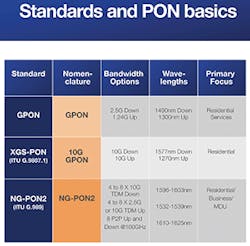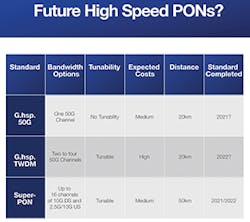The Real Deal With 5G, Wi-Fi 6, 10G, 50G PON —
If you’ve listened to the news lately, you must think that you are the only one without 5G service. It sounds like all the major carriers have rolled it out. The news has told us that Verizon has 5G service in multiple cities, and that AT&T has rolled out something they call 5GE, nationwide. It even showed up on my Apple iPhone X. Oddly, Apple says that the iPhone X doesn’t support 5G. Then the Wi-Fi Alliance came out with Wi-Fi 6, but what happened to Wi-Fi’s 1-5?
The confusion doesn’t stop there. Early this year CableLabs declared they had 10G, making it sound like they had just trumped 5G with something better. In reality, CableLabs 10G is talking about 10 Gbps symmetric speeds to the premises, not another generation of mobile network technology. Not to be left behind, 10G PON hasn’t been deployed significantly, and the news is already talking about 50G PON.
So, what is going on? Why is there so much hype in the news? It comes down to a simple fact: our vision of where technology is taking us says that we will need an amazing amount of bandwidth at the premises. Subscribers will be streaming video on all their devices. They will be video calling with the Amazon Echo Show or Facebook Portal and sharing videos with their friends and on social media. They will also be backing it all up in the cloud, which requires significantly more bandwidth.
InvisiLight® Solution for Deploying Fiber
April 2, 2022Go to Market Faster. Speed up Network Deployment
April 2, 2022Episode 10: Fiber Optic Closure Specs Explained…
April 1, 2022Food for Thought from Our 2022 ICT Visionaries
April 1, 2022In searching to answer the question of how much bandwidth I need at my home, I found a service provider that had a tool to help me calculate just that. It said I needed nearly 280 Mbps at my home. While that number is not likely right, especially since Netflix 4K streaming only requires 25Mbps and I only have one 4K TV, it does help to explain why we’re so focused on increasing bandwidth capacity for subscribers.
Whether subscribers need it or not, it’s clear that service providers must have higher bandwidth technology options in their arsenal. The alphabet soup of options begins at the subscriber premises with Wi-Fi. The new Wi-Fi 6 is really the next version of Wi-Fi, called 802.11ax. The Wi-Fi Alliance decided to rename all 6 versions. The new names help subscribers understand that they have the better Wi-Fi simply because it has a bigger number:
|
New Name |
Previous Name |
|
Wi-Fi 1 |
802.11b |
|
Wi-Fi 2 |
802.11a |
|
Wi-Fi 3 |
802.11g |
|
Wi-Fi 4 |
802.11n |
|
Wi-Fi 5 |
802.11ac |
|
Wi-Fi 6 |
802.11ax |
This clarity is important, as more than 75% of households with broadband use Wi-Fi for in-home connectivity (Source: Parks Associates 2018), and most subscribers equate Wi-Fi with Internet. This is a challenge for service providers to extend their services to include Wi-Fi. Even if they don’t offer Wi-Fi service, they will get the support calls.
The good news for service providers is that Wi-Fi 6 holds the promise of substantially improving the subscriber experience. What makes Wi-Fi 6 better includes:
• Increased bandwidth: up to 9.6 Gbps up from 3.5 Gbps on Wi-Fi 5.
• Increased capacity: ensuring all those smart home devices don’t overload the network.
• Reduced power consumption: enabling more battery powered Wi-Fi devices.
• Increased coverage: ensuring that everyone in the backyard at the BBQ has Wi-Fi.
The next challenge to delivering more bandwidth to the subscriber is the connection to the home. It is universally agreed that fiber will deliver the highest bandwidth with the most reliability. The challenge is: what is the best technology to use over that fiber?
The number of PON technologies now available, and in development, continues to increase, so the decision can be quite challenging. Currently the most widely deployed PON technology is GPON, which delivers 2.5 Gbps downstream and 1.24 Gbps upstream.
A standard since 2004, GPON is typically deployed with a split ratio of 64 or less. This means that GPON’s 2.5 Gbps of downstream bandwidth is spread across 64 subscribers. Service providers have been banking on the fact that subscribers are not all using their home or business networks at the same time. In reality, it’s a bit of a race. There will come a time when the amount of bandwidth used by all of subscribers on a PON during peak usage times exceeds what is available on the PON, and there will be some very unhappy subscribers.
To prevent this possibility, service providers are now looking at 10G PON technologies. Staying focused on the PON technologies that can co-exist with GPON on the same fiber, the options for deploying 10G PON are XGS-PON and NG-PON2. GPON, XGS-PON, and NG-PON2, are all International Telecommunications Union (ITU) standards. (See Figures 1 and 2.)
Figure 1.
Figure 2. PON technologies comparison: GPON, XGS-PON, and NG-PON2.
XGS-PON is a symmetric 10G downstream and 10G upstream technology that is deployed like GPON. It is essentially a higher bandwidth version of GPON.
NG-PON2 is a multi-wavelength PON that, also delivers 10G symmetric services like XGS-PON, but due to its multiple wavelengths provides several more benefits. Some of the key benefits of NG-PON2 include:
• Multiple wavelengths: 4 wavelengths today supporting 10G each, growing to 8 wavelengths in the future enabling as much as 80G of bandwidth.
• Channel bonding: Ability to bond the multiple wavelengths together to deliver more than 10G to subscribers on the PON to future-proof the network. This is especially helpful when a subscriber is looking for true 10G or greater services.
• Wavelength mobility: Ability for ONTs to range to another wavelength on command or when there is failure such as in a fiber cut.
• Point-to-Point wavelengths: Adds 8 additional wavelengths defined to be point-to-point services, increasing the supported bandwidth 160G symmetric.
As with any technology, the next version is always in development well before the previous one has been deployed. PON is no different. There are 3 new versions of PON in development within the ITU as shown in Figure 3. These new options will provide bandwidth options up to 200G as well as extended reach options beyond the traditional 20 km distance based on optical budgets. However, these new options are not likely to be standardized until 2021 at the earliest and therefore won’t be fully deployable until sometime later.
Figure 3. New PON technologies comparisons.
No discussion around next-generation technologies would be complete without talking about 5G. The emerging market consensus is that 5G will be deployed both at frequencies below 6 GHz and greater than 6 GHz to serve different purposes. Applications for 5G deployed at frequencies greater 6 GHz center around low bandwidth, low latency, and/or long-distance applications. These applications which include machine-to-machine and autonomous vehicles have a variety of unique requirements, and haven’t been the focus of the news and hype around 5G. Where the news has really focused is the applications for 5G that operate below 6 GHz. These include traditional cellular network and small cell deployments.
The small cell application is where 10G PON and 5G come together. In a small cell deployment like Verizon’s 5G Home, many 5G antennae are placed throughout a neighborhood to provide broadband coverage using the 5G network. Verizon is using this to deploy broadband wirelessly to subscriber homes outside of their traditional regions, and to deliver bandwidths of between 300 Mbps to 1 Gbps. This deployment model requires an access network to deliver the bandwidth to the antenna. NG-PON2 and its very high reliability, low latency, and channel bonding to gain more bandwidth as needed, make it a clear winner for this type of 5G deployment.
Like this Article?
Subscribe to ISE magazine and start receiving your FREE monthly copy today!
New broadband technologies will always be on the horizon as subscriber demands and new applications continue to drive innovation. The key to success for service providers will center around the ability to choose a technology that helps future-proof investments. By selecting a next-generation technology that can grow with expanded applications and bandwidth requirements, then service provider networks and subscribers will be satisfied for years to come.












